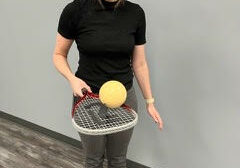Best Occupational Therapy Continuing Education Courses
Classé sous Non classé
Introduction à la formation continue en ergothérapie
Occupational therapy (OT) is a dynamic field that requires professionals to stay updated with the latest clinical practices, research, and treatment techniques. That’s where occupational therapy continuing education courses come into play. These courses not only help occupational therapists maintain their licenses but also expand their skill sets and improve patient outcomes.
In today’s fast-paced healthcare environment, therapists who commit to lifelong learning are the ones who thrive. Whether you’re a new graduate or a seasoned practitioner, investing in high-quality continuing education (CE) is the key to professional growth.

Why Continuing Education is Essential for Occupational Therapists
Staying Compliant with Licensing Boards
Most states in the U.S. require occupational therapists to complete a set number of continuing education units (CEUs) to maintain their license. These requirements ensure that therapists remain competent and up to date in their practice.
Advancing Career Opportunities
Pursuing CE courses can open doors to specialized roles, leadership positions, or advanced certifications. Employers often prefer candidates who show initiative by upgrading their knowledge.
Improving Patient Outcomes
Ultimately, CE courses benefit patients. By learning the latest evidence-based interventions, therapists can offer more effective treatments, reduce recovery times, and improve overall patient satisfaction.
Types of Occupational Therapy Continuing Education Courses
Cours en ligne à votre rythme
Flexible and convenient, self-paced occupational therapy courses are ideal for busy OTs. These allow learners to progress at their own speed and revisit modules when needed.
Live Webinars and Virtual Workshops
Interactive and engaging, these courses provide real-time learning with experts and allow participants to ask questions and join discussions.
In-Person Conferences and Seminars
Attending live events is a great way to earn CEUs while networking with peers, exploring new treatment tools, and learning directly from industry leaders.
Specialty Certification Programs
For therapists who want to specialize in areas like pediatrics, hand therapy, or mental health, certification programs offer structured learning and career advancement opportunities.
Top Topics Covered in OT Continuing Education
Ergothérapie pédiatrique
Focuses on developmental delays, sensory integration, and school-based interventions.
Geriatric Rehabilitation
Helps therapists address mobility, fall prevention, and independence in older adults.
Neurological Disorders and Stroke Recovery
Covers rehabilitation strategies for patients with brain injuries, multiple sclerosis, or Parkinson’s disease.
Hand Therapy and Orthopedics
Specialized training in upper limb rehabilitation, post-surgical recovery, and splinting.
Mental Health in Occupational Therapy
Equips therapists with tools to support patients with anxiety, depression, and trauma-related conditions.
Comment choisir le bon cours de formation continue
Considering State Licensure Requirements
Each state board has its own CEU rules. Always check your state’s requirements before enrolling.
Matching Courses to Career Goals
If you aim to work in pediatrics, look for courses in sensory integration or early childhood development. Align your learning with your career ambitions.
Budgeting for CEUs
Some platforms offer unlimited packages, while others charge per course. Choose the one that fits your budget and learning style.
Tips for Success in Occupational Therapy Continuing Education
Gestion du temps pour les thérapeutes occupés
Create a schedule that allows you to balance patient care, personal life, and professional learning.
Applying Knowledge to Clinical Practice
Don’t just take notes—implement what you learn into your daily therapy sessions.
Networking with Fellow Professionals
CE opportunities often bring therapists together. Engage in discussions and build a professional support system.
FAQs on Occupational Therapy Continuing Education Courses
Q1: How many CEUs do I need to maintain my OT license?
Requirements vary by state, but most require between 12–36 hours every renewal cycle.
Q2: Are online CE courses accepted by licensing boards?
Yes, but check with your state board. Many now accept accredited online courses.
Q3: What’s the most affordable way to earn CEUs?
Subscription platforms like Académie de thérapie de la main offer unlimited courses for a flat yearly fee. You can also purchase a lifetime access to individual courses.
Q4: Can CE courses help me specialize in a new area?
Absolutely! Many CE programs provide certifications in pediatrics, geriatrics, or hand therapy.
Q5: Do employers reimburse for CE courses?
Some healthcare organizations offer tuition reimbursement or CE stipends. Always ask your employer.
Q6: Which organization provides the most recognized CEUs?
Le AOTA is the most widely recognized body for occupational therapy continuing education.
Conclusion – Investing in Your OT Career
Continuing education is more than just a requirement—it’s an investment in your professional future. By taking the right occupational therapy continuing education courses, you not only maintain compliance but also enhance your skills, expand your career opportunities, and deliver better care to your patients.
Plus à lire
3 façons différentes d'incorporer des balles lestées dans les séances de thérapie de la main :
Par : Kelsey Melton 3 façons différentes d'incorporer des balles lestées dans les séances de traitement : Les balles lestées peuvent être incorporées de différentes manières dans les séances de traitement de thérapie de la main. Il s’agit d’une excellente intervention thérapeutique pour de nombreuses limitations et il est simple d’augmenter ou de diminuer la note en fonction des besoins du patient. Voici quelques idées d’exercices pour vous aider…
En savoir plusDifférencier le piégeage du nerf médian proximal du syndrome du canal carpien
Par : Brittany Day Piégeage du nerf médian proximal, syndrome pronateur ou syndrome de Lacertus ? Le syndrome pronateur est un terme utilisé pour décrire le piégeage du nerf médian proximal (PMNE) dans l'avant-bras. Le syndrome du pronateur et le syndrome de Lacertus sont parfois utilisés de manière interchangeable pour décrire le piégeage du nerf médian proximal, distal par rapport au ligament de Struthers et proximal par rapport au fléchisseur superficiel…
En savoir plusThérapie de la main en tant que nouveau diplômé ou étudiant
Conseils pour se préparer à la thérapie de la main en tant que nouveau diplômé ou chercheur sur le terrain de niveau II Tout ce que vous devez savoir en thérapie de la main commence par l'anatomie des membres supérieurs. Voici une liste de contrôle rapide à examiner et, espérons-le, à vous aider à démarrer dans votre nouveau cadre de thérapie de la main. Par : Tristany Hightower Je suggère, comme…
En savoir plusInscrivez-vous pour recevoir des mises à jour directement dans votre boîte de réception !
Inscrivez-vous avec nous et nous vous enverrons régulièrement des articles de blog sur tout ce qui concerne la thérapie des mains, des notifications chaque fois que nous mettons en ligne de nouvelles vidéos et tutoriels, ainsi que des documents, des protocoles et d'autres informations utiles.





